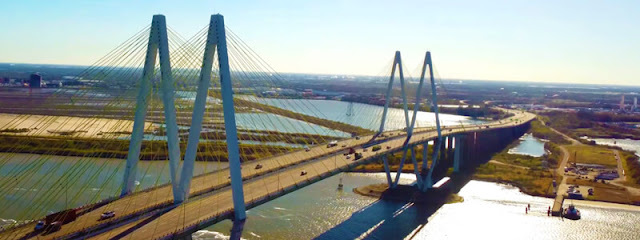 |
| Patrick Feller Flickr, License: Creative Commons Attribution (CC BY) Fred Hartman Bridge, Baytown, Texas 1209261519 |
 |
| John Weeks This bridge replaced a tunnel that was removed when the channel was deepened to 45' (13.7m). "The Hartman Bridge is huge any way you look at it. Another bridge that compares is the Arthur Ravenel Jr. Bridge in Charleston, South Carolina. Both bridges are about the same length, about the same main span, and both carry 8 lanes of traffic. While the Ravenel bridge solved this problem with a single span that carries all 8 lanes, the Hartman bridge has two spans of 4 lanes each. This lead to the Hartman bridge having 4 towers rather than two, and nearly double the number of stay cables. A secondary result of having more stay cables is that they towers did not need to be nearly as tall. In fact, the towers on the Hartman bridge are nearly 100 feet shorter than the Ravenel bridge. "The Fred Hartman Bridge suffered from a characteristic that many cable stay bridges have, and that is vibration in the cables that starts during a light rain. These vibrations have lead to over 100 welds failing on the structure. A solution using dampening cables was installed, which as largely solved the problem. The bridge has since been inspected and repaired." |
Carol caught the bridge when dampening ties were added.
 |
| LC-DIG-highsm- 18764 (ONLINE) [P&P], 2012 October Credit line: West Virginia Collection within the Carol M. Highsmith Archive, Library of Congress, Prints and Photographs Division. Carol M. Highsmith's photographs are in the public domain. |
 |
| Highway Engineering Discoveries posted Highway Engineering Discoveries posted again Puente Fred Hartman Bridge |
 |
| Bill Baumgartner commented on the second post by Highway Engineering Discoveries |
 |
| Highway Engineering Discoveries posted Fred Hartman Bridge Cable-stayed bridge in Houston, Texas HED posted |
 |
| TexasCapital "The bridge was constructed in 1985 and cost $91 million to build. It stands 440 [124m] feet tall and stretches 2.6 miles [4.2km] long. At the time of its construction, it was the longest cable-stayed bridge in the world." [The article provides the years 1989, 1992 and 1995 for the completion. The actual facts are that the construction started in 1986 and finished in 1995.] The span is 2,800' (0.5 mile, 853m), and the deck is supported by 448 cables. The main span is over 1,200" (.23 mile, 366m) It has a clearance of 178' (54m). "The bridge was named after Fred Hartman, a renowned newspaper editor and publisher who was instrumental in its construction." |
 |
| wbctx "At 436 feet [133m] high, the bridge features a fan arranged cable stay arrangement and provides a vertical clearance of 262 feet." It agrees with the cost of $91m. It disagrees with the vertical clearance of 178'. I think the 262' specification is wrong. |
This source puts the clearance at 178' and the cost at $117m. And this source agrees with 178' and $117m.
 |
| aecom "Today, it is one of the world’s most well-known cable-stayed bridges, accommodating 200,000 vehicles per day. AECOM developed the unique, award-winning double-diamond towers that stand as tall as a 45 story building yet efficiently resist hurricane winds. The cable-stayed main span unit is 2,475 feet long [450m] – the length of eight football fields – and allows eight lanes of traffic to smoothly flow 175 feet over the Houston Ship Channel." |
This shows another solution for cable ties to dampen the vibrations in the main cables.
 |
| 1:40 video @ 1:15 |
I tried to use street view to find more views of the cable ties. But I couldn't find any. So what is the current solution for dampening the vibrations of the stay cables? I also could not find any cable ties in the 3D satellite views.
 |
| Street View, May 2023 |
There were a lot of street views. The oldest one does show the cable ties. They disappeared between Jun 2013 and Jul 2015.
 |
| Street View, Mar 2008 |
I drove across that bridge several times while living in Houston. The double-diamond towers are so cool looking when you're approaching, and the height over the channel driving over it is pretty amazing. I always thought "this is way too much bridge for how much traffic it handles", but I suppose it handled less traffic in the 1990s when I lived in Houston than it does today.
ReplyDelete